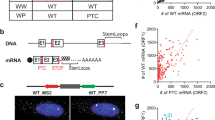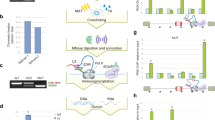Abstract
Aberrant mRNAs harboring premature termination codons (PTCs or nonsense codons) are degraded by the nonsense-mediated mRNA decay (NMD) pathway. mRNAs transcribed from genes that naturally acquire PTCs during lymphocyte development are strongly downregulated by PTCs. Here we show that a signal essential for this robust mRNA downregulatory response is efficient RNA splicing. Strong mRNA downregulation can be conferred on a poor NMD substrate by either strengthening its splicing signals or removing its weak introns. Efficient splicing also strongly promotes translation, providing a molecular explanation for enhanced NMD and suggesting that efficient splicing may have evolved to enhance both protein production and RNA surveillance. Our results suggest simple approaches for increasing protein expression from expression vectors and treating human genetic diseases caused by nonsense and frameshift mutations.
This is a preview of subscription content, access via your institution
Access options
Subscribe to this journal
Receive 12 print issues and online access
$189.00 per year
only $15.75 per issue
Buy this article
- Purchase on Springer Link
- Instant access to full article PDF
Prices may be subject to local taxes which are calculated during checkout








Similar content being viewed by others
References
Frischmeyer, P.A. & Dietz, H.C. Nonsense-mediated mRNA decay in health and disease. Hum. Mol. Genet. 8, 1893–1900 (1999).
Jacobson, A. & Peltz, S.W. Interrelationships of the pathways of mRNA decay and translation in eukaryotic cells. Annu. Rev. Biochem. 65, 693–739 (1996).
Maquat, L.E. Nonsense-mediated mRNA decay: splicing, translation and mRNP dynamics. Nat. Rev. Mol. Cell Biol. 5, 89–99 (2004).
Wilkinson, M.F. A new function for nonsense-mediated mRNA-decay factors. Trends Genet. 21, 143–148 (2005).
Holbrook, J.A., Neu-Yilik, G., Hentze, M.W. & Kulozik, A.E. Nonsense-mediated decay approaches the clinic. Nat. Genet. 36, 801–808 (2004).
Carter, M.S., Li, S. & Wilkinson, M.F. A splicing-dependent regulatory mechanism that detects translation signals. EMBO J. 15, 5965–5975 (1996).
Brocke, K.S., Neu-Yilik, G., Gehring, N.H., Hentze, M.W. & Kulozik, A.E. The human intronless melanocortin 4-receptor gene is NMD insensitive. Hum. Mol. Genet. 11, 331–335 (2002).
Maquat, L.E. & Li, X. Mammalian heat shock p70 and histone H4 transcripts, which derive from naturally intronless genes, are immune to nonsense-mediated decay. RNA 7, 445–456 (2001).
Le Hir, H., Izaurralde, E., Maquat, L.E. & Moore, M.J. The spliceosome deposits multiple proteins 20–24 nucleotides upstream of mRNA exon-exon junctions. EMBO J. 19, 6860–6869 (2000).
Wagner, E. & Lykke-Andersen, J. mRNA surveillance: the perfect persist. J. Cell Sci. 115, 3033–3038 (2002).
Li, S. & Wilkinson, M.F. Nonsense surveillance in lymphocytes? Immunity 8, 135–141 (1998).
Gudikote, J.P. & Wilkinson, M.F. T-cell receptor sequences that elicit strong down-regulation of premature termination codon-bearing transcripts. EMBO J. 21, 125–134 (2002).
Cheng, J., Fogel-Petrovic, M. & Maquat, L.E. Translation to near the distal end of the penultimate exon is required for normal levels of spliced triosephosphate isomerase mRNA. Mol. Cell. Biol. 10, 5215–5225 (1990).
Carter, M.S. et al. A regulatory mechanism that detects premature nonsense codons in T-cell receptor transcripts in vivo is reversed by protein synthesis inhibitors in vitro. J. Biol. Chem. 270, 28995–29003 (1995).
Liu, H.X., Zhang, M. & Krainer, A.R. Identification of functional exonic splicing enhancer motifs recognized by individual SR proteins. Genes Dev. 12, 1998–2012 (1998).
Audibert, A., Weil, D. & Dautry, F. In vivo kinetics of mRNA splicing and transport in mammalian cells. Mol. Cell. Biol. 22, 6706–6718 (2002).
Li, S., Leonard, D. & Wilkinson, M.F. T cell receptor (TCR) mini-gene mRNA expression regulated by nonsense codons: a nuclear-associated translation-like mechanism. J. Exp. Med. 185, 985–992 (1997).
Wang, J., Vock, V.M., Li, S., Olivas, O.R. & Wilkinson, M.F. A quality control pathway that down-regulates aberrant T-cell receptor (TCR) transcripts by a mechanism requiring UPF2 and translation. J. Biol. Chem. 277, 18489–18493 (2002).
Nott, A., Le Hir, H. & Moore, M.J. Splicing enhances translation in mammalian cells: an additional function of the exon junction complex. Genes Dev. 18, 210–222 (2004).
Buzina, A. & Shulman, M.J. Infrequent translation of a nonsense codon is sufficient to decrease mRNA level. Mol. Biol. Cell 10, 515–524 (1999).
Buhler, M., Paillusson, A. & Muhlemann, O. Efficient downregulation of immunoglobulin mu mRNA with premature translation-termination codons requires the 5′-half of the VDJ exon. Nucleic Acids Res. 32, 3304–3315 (2004).
Kessler, O. & Chasin, L.A. Effects of nonsense mutations on nuclear and cytoplasmic adenine phosphoribosyltransferase RNA. Mol. Cell. Biol. 16, 4426–4435 (1996).
Urlaub, G., Mitchell, P.J., Ciudad, C.J. & Chasin, L.A. Nonsense mutations in the dihydrofolate reductase gene affect RNA processing. Mol. Cell. Biol. 9, 2868–2880 (1989).
Lewis, B.P., Green, R.E. & Brenner, S.E. Evidence for the widespread coupling of alternative splicing and nonsense-mediated mRNA decay in humans. Proc. Natl. Acad. Sci. USA 100, 189–192 (2003).
Mendell, J.T., Sharifi, N.A., Meyers, J.L., Martinez-Murillo, F. & Dietz, H.C. Nonsense surveillance regulates expression of diverse classes of mammalian transcripts and mutes genomic noise. Nat. Genet. 36, 1073–1078 (2004).
Mitrovich, Q.M. & Anderson, P. Unproductively spliced ribosomal protein mRNAs are natural targets of mRNA surveillance in C. elegans. Genes Dev. 14, 2173–2184 (2000).
Morrison, M., Harris, K.S. & Roth, M.B. smg mutants affect the expression of alternatively spliced SR protein mRNAs in Caenorhabditis elegans. Proc. Natl. Acad. Sci. USA 94, 9782–9785 (1997).
Wiegand, H.L., Lu, S. & Cullen, B.R. Exon junction complexes mediate the enhancing effect of splicing on mRNA expression. Proc. Natl. Acad. Sci. USA 100, 11327–11332 (2003).
Custodio, N. et al. In vivo recruitment of exon junction complex proteins to transcription sites in mammalian cell nuclei. RNA 10, 622–633 (2004).
Sanford, J.R., Gray, N.K., Beckmann, K. & Caceres, J.F. A novel role for shuttling SR proteins in mRNA translation. Genes Dev. 18, 755–768 (2004).
Zhang, Z. & Krainer, A.R. Involvement of SR Proteins in mRNA Surveillance. Mol. Cell 16, 597–607 (2004).
Zolotukhin, A.S., Tan, W., Bear, J., Smulevitch, S. & Felber, B.K. U2AF participates in the binding of TAP (NXF1) to mRNA. J. Biol. Chem. 277, 3935–3942 (2002).
Dahlberg, J.E., Lund, E. & Goodwin, E.B. Nuclear translation: what is the evidence? RNA 9, 1–8 (2003).
Iborra, F.J., Jackson, D.A. & Cook, P.R. The case for nuclear translation. J. Cell Sci. 117, 5713–5720 (2004).
Wilkinson, M.F. & Shyu, A.B. RNA surveillance by nuclear scanning? Nat. Cell Biol. 4, E144–E147 (2002).
Aoufouchi, S., Yelamos, J. & Milstein, C. Nonsense mutations inhibit RNA splicing in a cell-free system: recognition of mutant codon is independent of protein synthesis. Cell 85, 415–422 (1996).
Gersappe, A., Burger, L. & Pintel, D.J. A premature termination codon in either exon of minute virus of mice P4 promoter-generated pre-mRNA can inhibit nuclear splicing of the intervening intron in an open reading frame-dependent manner. J. Biol. Chem. 274, 22452–22458 (1999).
Lozano, F., Maertzdorf, B., Pannell, R. & Milstein, C. Low cytoplasmic mRNA levels of immunoglobulin kappa light chain genes containing nonsense codons correlate with inefficient splicing. EMBO J. 13, 4617–4622 (1994).
Muhlemann, O. et al. Precursor RNAs harboring nonsense codons accumulate near the site of transcription. Mol. Cell 8, 33–43 (2001).
Naeger, L.K., Schoborg, R.V., Zhao, Q., Tullis, G.E. & Pintel, D.J. Nonsense mutations inhibit splicing of MVM RNA in cis when they interrupt the reading frame of either exon of the final spliced product. Genes Dev. 6, 1107–1119 (1992).
Lytle, J.R. & Steitz, J.A. Premature termination codons do not affect the rate of splicing of neighboring introns. RNA 10, 657–668 (2004).
Dietz, H.C. & Kendzior, R.J., Jr. Maintenance of an open reading frame as an additional level of scrutiny during splice site selection. Nat. Genet. 8, 183–188 (1994).
Li, B. et al. Stop codons affect 5′ splice site selection by surveillance of splicing. Proc. Natl. Acad. Sci. USA 99, 5277–5282 (2002).
Wang, J., Chang, Y.F., Hamilton, J.I. & Wilkinson, M.F. Nonsense-associated altered splicing: a frame-dependent response distinct from nonsense-mediated decay. Mol. Cell 10, 951–957 (2002).
Wang, J., Hamilton, J.I., Carter, M.S., Li, S. & Wilkinson, M.F. Alternatively spliced TCR mRNA induced by disruption of reading frame. Science 297, 108–110 (2002).
Gersappe, A. & Pintel, D.J. A premature termination codon interferes with the nuclear function of an exon splicing enhancer in an open reading frame-dependent manner. Mol. Cell. Biol. 19, 1640–1650 (1999).
Wang, J. & Wilkinson, M.F. Site-directed mutagenesis of large (13-kb) plasmids in a single-PCR procedure. Biotechniques 29, 976–978 (2000).
Wang, J., Gudikote, J.P., Olivas, O.R. & Wilkinson, M.F. Boundary-independent polar nonsense-mediated decay. EMBO Rep. 3, 274–279 (2002).
Parks, D.R. & Herzenberg, L.A. Fluorescence-activated cell sorting: theory, experimental optimization, and applications in lymphoid cell biology. Methods Enzymol. 108, 197–241 (1984).
Chen, C.A. & Okayama, H. Calcium phosphate-mediated gene transfer: a highly efficient transfection system for stably transforming cells with plasmid DNA. Biotechniques 6, 632–638 (1988).
Acknowledgements
We thank Y.-J. Liu and Y.-H. Wang for technical advice on FACS analysis, A. Bhalla for technical assistance and G. Cote for useful comments. This study was supported by the US National Institutes of Health grant GM058595 and the Kleberg Fund for Innovative Research Program Allocation for IRG (M.D. Anderson Cancer Center).
Author information
Authors and Affiliations
Corresponding author
Ethics declarations
Competing interests
The authors declare no competing financial interests.
Supplementary information
Supplementary Fig. 1
Deletions in the VDJ exon do not affect NMD. (PDF 248 kb)
Supplementary Fig. 2
A mutation in the 3′ splice site of TCRβ IVS1 dramatically reduces the magnitude of downregulation in response to a PTC. (PDF 134 kb)
Rights and permissions
About this article
Cite this article
Gudikote, J., Imam, J., Garcia, R. et al. RNA splicing promotes translation and RNA surveillance. Nat Struct Mol Biol 12, 801–809 (2005). https://doi.org/10.1038/nsmb980
Received:
Accepted:
Published:
Issue Date:
DOI: https://doi.org/10.1038/nsmb980
This article is cited by
-
Nonsense-mediated RNA decay: an emerging modulator of malignancy
Nature Reviews Cancer (2022)
-
The exon junction complex as a node of post-transcriptional networks
Nature Reviews Molecular Cell Biology (2016)
-
Method for quantitative analysis of nonsense-mediated mRNA decay at the single cell level
Scientific Reports (2015)
-
A minimal cytomegalovirus intron A variant can improve transgene expression in different mammalian cell lines
Biotechnology Letters (2013)
-
NMD: a multifaceted response to premature translational termination
Nature Reviews Molecular Cell Biology (2012)



